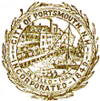Portsmouth, New Hampshire
| Portsmouth, New Hampshire | ||
|---|---|---|
| City | ||
|
Market Square | ||
| ||
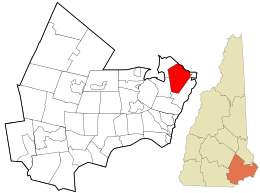 Location in Rockingham County and the state of New Hampshire. | ||
| Coordinates: 43°4′32″N 70°45′38″W / 43.07556°N 70.76056°WCoordinates: 43°4′32″N 70°45′38″W / 43.07556°N 70.76056°W | ||
| Country | United States | |
| State | New Hampshire | |
| County | Rockingham | |
| Settled | 1630 | |
| Incorporated | 1653 | |
| Incorporated (city) | 1849 | |
| Government | ||
| • Mayor | Jack Blalock | |
| • Assistant mayor | Cliff Lazenby | |
| • City council |
Members
| |
| • City manager | John P. Bohenko | |
| Area | ||
| • Total | 16.8 sq mi (43.6 km2) | |
| • Land | 15.6 sq mi (40.5 km2) | |
| • Water | 1.2 sq mi (3.1 km2) 7.21% | |
| Elevation | 20 ft (6 m) | |
| Population (2010) | ||
| • Total | 21,233 | |
| • Estimate (2016)[1] | 21,485 | |
| • Density | 1,374/sq mi (530.6/km2) | |
| Time zone | UTC−5 (Eastern) | |
| • Summer (DST) | UTC−4 (Eastern) | |
| ZIP codes | 03801–03804 | |
| Area code(s) | 603 | |
| FIPS code | 33-62900 | |
| GNIS feature ID | 0869312 | |
| Website |
cityofportsmouth | |

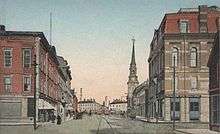

.jpg)
Portsmouth is a city in Rockingham County, New Hampshire, in the United States. It is the only city in the county, but only the fourth-largest community,[2] with a population of 21,233 at the 2010 census.[3] As of 2016 the estimated population was 21,485.[1] A historic seaport and popular summer tourist destination, Portsmouth was the home of the Strategic Air Command's Pease Air Force Base, later converted to Portsmouth International Airport at Pease with limited commercial air service.
History
American Indians of the Abenaki and other Algonquian languages-speaking nations, and their predecessors, inhabited the territory of coastal New Hampshire for thousands of years before European contact.
The first known European to explore and write about the area was Martin Pring in 1603. The Piscataqua River is a tidal estuary with a swift current, but forms a good natural harbor. The west bank of the harbor was settled by English colonists in 1630 and named Strawbery Banke, after the many wild strawberries growing there. The village was fortified by Fort William and Mary. Strategically located for trade between upstream industries and mercantile interests abroad, the port prospered. Fishing, lumber and shipbuilding were principal businesses of the region.[4] Enslaved Africans were imported as laborers as early as 1645 and were integral to building the city's prosperity.[5] Portsmouth was part of the Triangle Trade, which made significant profits from slavery.
At the town's incorporation in 1653, it was named Portsmouth in honor of the colony's founder, John Mason. He had been captain of the port of Portsmouth, England, in the county of Hampshire, for which New Hampshire is named.
When Queen Anne's War ended in 1712, the town was selected by Governor Joseph Dudley to host negotiations for the 1713 Treaty of Portsmouth, which temporarily ended hostilities between the Abenaki Indians and English settlements of the Province of Massachusetts Bay and New Hampshire.[4]
In 1774, in the lead-up to the Revolution, Paul Revere rode to Portsmouth warning that the British were coming, with warships to subdue the port.[6] Although the harbor was protected by Fort William and Mary, the rebel government moved the capital inland to Exeter, safe from the Royal Navy. The Navy bombarded Falmouth (now Portland, Maine) on October 18, 1775. African Americans helped defend Portsmouth and New England during the war. In 1779, 19 slaves from Portsmouth wrote a petition to the state legislature and asked that it abolish slavery, in recognition of their war contributions and in keeping with the principles of the Revolution.[5] Their petition was not answered then, but New Hampshire later ended slavery.
Thomas Jefferson's 1807 embargo against trade with Britain withered New England's trade with Canada, and a number of local fortunes were lost. Others were gained by men who acted as privateers during the War of 1812. In 1849, Portsmouth was incorporated as a city.[4]
Once one of the nation's busiest ports and shipbuilding cities, Portsmouth expressed its wealth in fine architecture. It contains significant examples of Colonial, Georgian, and Federal style houses, a selection of which are now museums. Portsmouth's heart contains stately brick Federalist stores and townhouses, built all-of-a-piece after devastating early 19th-century fires. The worst was in 1813 when 244 buildings burned.[4] A fire district was created that required all new buildings within its boundaries to be built of brick with slate roofs; this created the downtown's distinctive appearance. The city was also noted for the production of boldly wood-veneered Federalist furniture, particularly by the master cabinet maker Langley Boardman.
The Industrial Revolution spurred economic growth in New Hampshire mill towns such as Dover, Keene, Laconia, Manchester, Nashua and Rochester, where rivers provided water power for the mills. It shifted growth to the new mill towns. The port of Portsmouth declined, but the city survived through Victorian-era doldrums, a time described in the works of Thomas Bailey Aldrich, particularly in his 1869 novel The Story of a Bad Boy.
In the 20th century, the city founded a Historic District Commission, which has worked to protect much of the city's irreplaceable architectural legacy. In 2008, Portsmouth was named one of the "Dozen Distinctive Destinations" by the National Trust for Historic Preservation.[7] The compact and walkable downtown on the waterfront draws tourists and artists, who each summer throng the cafes, restaurants and shops around Market Square. Portsmouth annually celebrates the revitalization of its downtown (in particular Market Square) with Market Square Day,[8] a celebration dating back to 1977, produced by the non-profit Pro Portsmouth, Inc.
Portsmouth shipbuilding history has had a long symbiotic relationship with Kittery, Maine, across the Piscataqua River. In 1781–1782, the naval hero John Paul Jones lived in Portsmouth while supervising construction of his ship Ranger, which was built on nearby Badger's Island in Kittery. During that time, he boarded at the Captain Gregory Purcell house, which now bears Jones' name, as it is the only surviving property in the United States associated with him. Built by the master housewright Hopestill Cheswell, an African American,[9] it has been designated as a National Historic Landmark. It now serves as the Portsmouth Historical Society Museum.
The Portsmouth Naval Shipyard, established in 1800 as the first federal navy yard, is located on Seavey's Island in Kittery, Maine.[10] The base is famous for being the site of the 1905 signing of the Treaty of Portsmouth[11] which ended the Russo-Japanese War. Though US President Theodore Roosevelt orchestrated the peace conference that brought Russian and Japanese diplomats to Portsmouth and the Shipyard, he never came to Portsmouth, relying on the Navy and people of New Hampshire as the hosts. Roosevelt won the 1906 Nobel Peace Prize for his diplomacy in bringing about an end to the War.
21st century
In 2006, Portsmouth became an Eco-municipality.[12]
The city announced construction of a 600-space garage, the city's second downtown parking garage, to begin in April or May 2017. The $1.9 million project is being built on a new street called Deer Street Extension and is expected to be completed by September 2018.[13]
In 2018 the City of Portsmouth became a member of the WHO Global Network for Age-friendly Cities and Communities. As a member, City of Portsmouth is part of a growing global movement of communities, cities and other sub-national levels of government that are striving to better meet the needs of their older residents.
Local cultural attractions include the Portsmouth Symphony Orchestra, the Portsmouth Music and Arts Center, the West End Studio Theatre, maker spaces and craft breweries.[14]
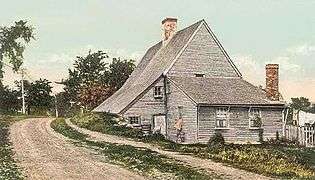 Jackson House (built 1664) as it appeared in 1909
Jackson House (built 1664) as it appeared in 1909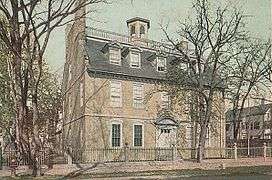 Warner House (built 1716) as it appeared in 1902
Warner House (built 1716) as it appeared in 1902 Wentworth-Coolidge Mansion (built 1750) as it appeared in 1902
Wentworth-Coolidge Mansion (built 1750) as it appeared in 1902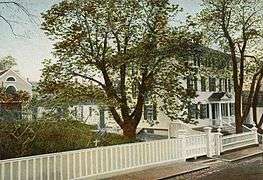 Moffatt-Ladd House (built 1763), home of William Whipple, as it appeared in 1905
Moffatt-Ladd House (built 1763), home of William Whipple, as it appeared in 1905- Governor Langdon House (1784)
- Governor Goodwin Mansion (c. 1811), Strawbery Banke Museum
- Old Custom House & Post Office (1860), designed by Ammi B. Young
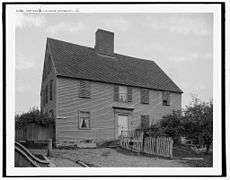 First Wentworth House (c. 1907)
First Wentworth House (c. 1907) Portsmouth Bridge, ca. 1910
Portsmouth Bridge, ca. 1910
Geography
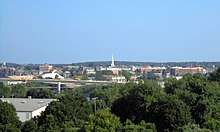
According to the United States Census Bureau, the city has a total area of 16.8 square miles (43.6 km2), of which 15.6 square miles (40.5 km2) is land and 1.2 square miles (3.1 km2), or 7.21%, is water.[3] Portsmouth is drained by Sagamore Creek and the Piscataqua River. The highest point in the city is 110 feet (34 m) above sea level, within Pease International Airport.
The city is crossed by Interstate 95, U.S. Route 1, U.S. Route 4, New Hampshire Route 1A, New Hampshire Route 16, and New Hampshire Route 33. Boston is 55 miles (89 km) to the south, Portland, Maine, is 53 miles (85 km) to the northeast, and Dover, New Hampshire, is 13 miles (21 km) to the northwest.
Climate
Portsmouth has a humid continental climate[15] in spite of its maritime position, due to prevailing inland winds. Summers are moderately warm with winter days averaging around the freezing point, but with cold nights bringing it below the required −3 °C (27 °F) isotherm to have a humid continental climate. With high year-round precipitation, the cold winters can often be very snowy and summers wet.[16]
| Climate data for Portsmouth | |||||||||||||
|---|---|---|---|---|---|---|---|---|---|---|---|---|---|
| Month | Jan | Feb | Mar | Apr | May | Jun | Jul | Aug | Sep | Oct | Nov | Dec | Year |
| Average high °F (°C) | 32 (0) |
32 (0) |
41 (5) |
52 (11) |
64 (18) |
73 (23) |
79 (26) |
77 (25) |
70 (21) |
59 (15) |
48 (9) |
34 (1) |
54 (12) |
| Daily mean °F (°C) | 25 (−4) |
25 (−4) |
34 (1) |
45 (7) |
54 (12) |
64 (18) |
70 (21) |
68 (20) |
61 (16) |
50 (10) |
41 (5) |
28 (−2) |
46 (8) |
| Average low °F (°C) | 16 (−9) |
18 (−8) |
27 (−3) |
36 (2) |
45 (7) |
55 (13) |
61 (16) |
59 (15) |
52 (11) |
41 (5) |
34 (1) |
21 (−6) |
37 (3) |
| Average rainfall inches (mm) | 3.66 (93) |
3.86 (98) |
3.35 (85) |
3.23 (82) |
3.23 (82) |
2.83 (72) |
3.11 (79) |
2.24 (57) |
3.7 (94) |
3.66 (93) |
5.08 (129) |
4.45 (113) |
42.32 (1,075) |
| Source: [16] | |||||||||||||
Demographics
| Historical population | |||
|---|---|---|---|
| Census | Pop. | %± | |
| 1790 | 4,720 | — | |
| 1800 | 5,339 | 13.1% | |
| 1810 | 6,934 | 29.9% | |
| 1820 | 7,327 | 5.7% | |
| 1830 | 8,026 | 9.5% | |
| 1840 | 7,887 | −1.7% | |
| 1850 | 9,738 | 23.5% | |
| 1860 | 9,335 | −4.1% | |
| 1870 | 9,211 | −1.3% | |
| 1880 | 9,690 | 5.2% | |
| 1890 | 9,827 | 1.4% | |
| 1900 | 10,637 | 8.2% | |
| 1910 | 11,269 | 5.9% | |
| 1920 | 13,569 | 20.4% | |
| 1930 | 14,495 | 6.8% | |
| 1940 | 14,821 | 2.2% | |
| 1950 | 18,830 | 27.0% | |
| 1960 | 26,900 | 42.9% | |
| 1970 | 25,717 | −4.4% | |
| 1980 | 26,254 | 2.1% | |
| 1990 | 25,925 | −1.3% | |
| 2000 | 20,784 | −19.8% | |
| 2010 | 21,233 | 2.2% | |
| Est. 2016 | 21,485 | [1] | 1.2% |
| sources:[3][17] | |||
As of the census of 2010, there were 21,233 people, 10,014 households, and 4,736 families residing in the city. The population density was 1,361.1 people per square mile (524.4/km²). There were 10,625 housing units at an average density of 681.1 per square mile (262.3/km²). The racial makeup of the city was 91.5% White, 1.7% African American, 0.2% Native American, 3.5% Asian, 0.01% Pacific Islander, 0.7% some other race, and 2.3% from two or more races. Hispanic or Latino of any race were 2.8% of the population.[18]
There were 10,014 households, out of which 20.2% had children under the age of 18 living with them, 35.5% were headed by married couples living together, 8.3% had a female householder with no husband present, and 52.7% were non-families. 39.2% of all households were made up of individuals, and 11.8% were someone living alone who was 65 years of age or older. The average household size was 2.03, and the average family size was 2.75.[18]
In the city, the population was spread out with 16.6% under the age of 18, 7.7% from 18 to 24, 32.2% from 25 to 44, 27.6% from 45 to 64, and 15.9% who were 65 years of age or older. The median age was 40.3 years. For every 100 females, there were 94.2 males. For every 100 females age 18 and over, there were 92.6 males.[18]
For the period 2010–14, the estimated median annual income for a household in the city was $67,679, and the median income for a family was $90,208. Male full-time workers had a median income of $58,441 versus $45,683 for females. The per capita income for the city was $42,724. About 4.0% of families and 7.6% of the population were below the poverty line, including 6.9% of those under age 18 and 7.1% of those age 65 or over.[19]
Government and politics
The city of Portsmouth operates under a council-manager system of government. Portsmouth elects a nine-member at-large City Council to serve as the city's primary legislative body.[20] The candidate who receives the highest number of votes is designated the Mayor (currently Jack Blalock), while the candidate receiving the second-highest vote total is designated the Assistant Mayor (currently James R. Splaine). While the mayor and council convene to establish municipal policy, the day-to-day operations of the city government are overseen by the City Manager (currently John Bohenko).[21]
Portsmouth is part of New Hampshire's 1st congressional district, currently represented by Democrat Carol Shea-Porter. Portsmouth is part of the Executive Council's 3rd district, currently represented by Republican Russell Prescott. In the State Senate, Portsmouth is represented by Democrat Martha Fuller Clark. In the State House of Representatives, Portsmouth is divided among the 25th through 31st Rockingham districts.[22][23]
| Year | Democratic | Republican |
|---|---|---|
| 2016 | 67.7% 8,911 | 27.6% 3,632 |
| 2012 | 67.6% 8,828 | 31.3% 4,088 |
| 2008 | 70.4% 9,147 | 28.7% 3,729 |
| 2004 | 66.4% 8,436 | 33.0% 4,185 |
| 2000 | 59.9% 6,862 | 34.0% 3,896 |
| 1996 | 62.5% 6,343 | 29.7% 3,896 |
| 1992 | 51.7% 6,132 | 30.0% 3,563 |
| 1988 | 52.0% 5,377 | 46.7% 4,827 |
| 1984 | 46.9% 4,418 | 52.8% 4,967 |
| 1980 | 39.6% 3,666 | 43.5% 4,023 |
Politically, Portsmouth is a center of liberal politics and stronghold for the Democratic Party. In 2016, Portsmouth voted 67.70% for Hillary Clinton in the presidential election, 62.53% for Colin Van Ostern in the gubernatorial election, 64.48% for Maggie Hassan in the senatorial election, and 62.16% for Carol Shea-Porter in the congressional election.[25] In 2014, Portsmouth voted 70.05% for Maggie Hassan in the gubernatorial election, 67.34% for Jeanne Shaheen in the senatorial election, and 68.34% for Carol Shea-Porter in the congressional election. In 2012, Portsmouth voted 67.56% for Barack Obama in the presidential election, 70.16% for Maggie Hassan in the gubernatorial election, and 68.50% for Carol Shea-Porter in the congressional election.[26]
In March 2014, Portsmouth became the first municipality in New Hampshire to implement protections for city employees from discrimination on the basis of gender identity, by a 9–0 vote of the city council.[27]
Sites of interest
- USS Albacore Museum & Park – a museum featuring the USS Albacore, a U.S. Navy submarine used for testing, which was decommissioned in 1972 and moved to the park in 1985. The submarine is open for tours.
- Buckminster House – built in 1725, formerly a funeral parlor.[28][29]
- Discover Portsmouth Center – visitor center, gallery, gift shop, John Paul Jones Historic House, walking tours, short film on the history of Portsmouth; operated by the Portsmouth Historical Society.
- The Music Hall – a 900-seat theater originally opened in 1878. The theater is now run by a non-profit organization and is fully restored. The venue hosts musical acts, theater, dance and cinema.
- New Hampshire Theatre Project – founded in 1986, a non-profit theater organization producing contemporary and classical works, and offering educational programs.[30]
- North Church – historic church, the steeple of which is visible from most of Portsmouth
- Pontine Theatre – produces original theater works based on the history, culture and literature of New England at their 50-seat black box venue.[31]
- The Player's Ring Theater – a black-box theater that produces original work from local playwrights.
- Portsmouth Athenæum – a private membership library, museum and art gallery open to the public at certain times.
- Portsmouth Harbor Lighthouse – first established in 1771, the current structure was built in 1878 and is open for monthly tours from May through September.
- Prescott Park Arts Festival – summer entertainments in Portsmouth's waterfront park.[32]
- Seacoast Repertory Theatre – founded in 1988, a professional theater troupe.[33]
- Strawbery Banke Museum – a neighborhood featuring several dozen restored historic homes in Colonial, Georgian and Federal styles of architecture. The site of one of Portsmouth's earliest settlements.
- Whaling Wall – Painting of Isles of Shoals Humpbacks created by Robert Wyland, situated on the back of Cabot House Furniture. It is in disrepair, and restoration has not been allowed by the owners of Cabot Furniture.[34]
- Four public sculptures carved by Cabot Lyford stand in the city, including "The Whale" and "My Mother the Wind," a seven-ton blank granite statue which was installed on Portsmouth's waterfront in 1975.[35]
Historic house museums
- Richard Jackson House (1664)
- John Paul Jones House (1758)
- Governor John Langdon House (1784)
- Tobias Lear House (1740)
- Moffatt-Ladd House (1763)
- Rundlet-May House (1807)
- MacPheadris-Warner House (1716)
- Wentworth-Coolidge Mansion (1750)
- Wentworth-Gardner House (also called Wentworth House) (1760)
Economy
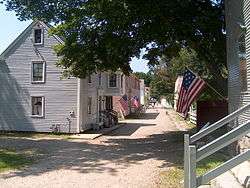
Heinemann USA is based in Portsmouth. Before its dissolution, Boston-Maine Airways (Pan Am Clipper Connection), a regional airline, was also headquartered in Portsmouth.[36] Companies with headquarters in Portsmouth include packaged software producer Bottomline Technologies and frozen yogurt maker Sweet Scoops.
Top employers
According to the city's 2012 Comprehensive Annual Financial Report,[37] the top ten employers in the city are:
| # | Employer | Employees |
|---|---|---|
| 1 | Hospital Corporation of America | 1,079 |
| 2 | Liberty Mutual Insurance | 1,013 |
| 3 | National Passport Center | 736 |
| 4 | Lonza Biologics | 727 |
| 5 | City of Portsmouth | 684 |
| 6 | National Visa Center | 644 |
| 7 | John Hancock Insurance | 400 |
| 8 | Bottomline Technologies | 350 |
| 9 | Thermo Fisher Scientific | 280 |
| 10 | Alpha Flying/Plane Sense | 270 |
Education
- Community College System of New Hampshire, Great Bay Community College – Portsmouth campus
- Franklin Pierce University – Portsmouth campus
- Granite State College – Portsmouth campus and on-site location at Great Bay Community College
Media
Radio
Sports
The Seacoast United Phantoms are a soccer team based in Portsmouth. Founded in 1996, the team plays in the USL Premier Development League (PDL), the fourth tier of the American Soccer Pyramid, in the Northeast Division of the Eastern Conference.
Sister cities
Portsmouth has six Sister Cities and one Friendship City as designated by Sister Cities International [38]






Friendship city:

Notable people
See also
References
- 1 2 3 "Population and Housing Unit Estimates". Retrieved June 9, 2017.
- ↑ The Rockingham County towns (not cities) of Derry (33,109), Salem (28,776), and Londonderry (24,129) had greater populations according to the 2010 census.
- 1 2 3 "Geographic Identifiers: 2010 Demographic Profile Data (G001): Portsmouth city, New Hampshire". American Factfinder. U.S. Census Bureau. Retrieved January 26, 2016. NOTE: Population revised December 20, 2011 from original figure of 20,779.
- 1 2 3 4 Coolidge, A. J.; J. B. Mansfield (1859). A History and Description of New England. Boston, Massachusetts: H. G. Houghton and Company. pp. 622–629.
- 1 2 Ring, Phyllis. "The Place Her People Made". The Heart of New England. Retrieved August 27, 2010.
- ↑ Robinson, J. Dennis. "Paul Revere's Other Ride". Seacoast NH History. Retrieved August 27, 2010.
- ↑ "Dozen Distinctive Destinations: Portsmouth, NH". Preservation Nation. Retrieved August 27, 2010.
- ↑ What is Market Square Day?
- ↑ Mark J. Sammons and Valerie Cunningham, Black Portsmouth: Three Centuries of African-American Heritage, (2004), pp. 32–33, accessed July 27, 2009
- ↑ Brewster, Charles W. "The Ship "America" and John Paul Jones". Seacoast NH. Retrieved August 27, 2010.
- ↑ "The Treaty of Portsmouth (Portsmouth Peace Treaty)". www.portsmouthpeacetreaty.org. Retrieved 2018-07-17.
- ↑ "Eco-municipalities". instituteforecomunicipalities.org. Retrieved August 27, 2010.
- ↑ McMenemy, Jeff. "Portsmouth to begin garage construction this spring". seacoastonline.com. Retrieved March 9, 2017.
- ↑ Haas, Kimberly (July 15, 2018). "Art scene helps fuel business in Portsmouth". Union Leader. Retrieved 2018-07-17.
- ↑ "Portsmouth, New Hampshire Climate Summary". Weatherbase. Retrieved February 5, 2015.
- 1 2 "Portsmouth, New Hampshire Temperature Averages". Weatherbase. Retrieved February 5, 2015.
- ↑ "Census" (PDF). United States Census. Archived from the original (PDF) on August 8, 2010. page 36
- 1 2 3 "Profile of General Population and Housing Characteristics: 2010 Census Summary File 1 (DP-1): Portsmouth city, New Hampshire". American Factfinder. U.S. Census Bureau. Retrieved January 26, 2016.
- ↑ "Selected Economic Characteristics: 2010–2014 American Community Survey 5-Year Estimates (DP03): Portsmouth city, New Hampshire". American Factfinder. U.S. Census Bureau. Retrieved January 26, 2016.
- ↑ "Portsmouth City Council, 2014 and 2015". City of Portsmouth. Retrieved June 6, 2015.
- ↑ "City Manager". City of Portsmouth. Retrieved June 6, 2015.
- ↑ "House Members". New Hampshire General Court. Retrieved November 12, 2017.
- ↑ "Voting Districts". New Hampshire Secretary of State. Retrieved November 12, 2017.
- ↑ "NHPR State of Democracy". Retrieved October 1, 2018.
- ↑ "State General Election Results" (PDF). City of Portsmouth. November 8, 2016. Retrieved November 11, 2016.
- ↑ "Election Results". Portsmouth, New Hampshire City Clerk. Retrieved June 6, 2015.
- ↑ Emily Corwin. "Portsmouth City Council Unanimously Approves Gender Identity Protection". New Hampshire Public Radio. Retrieved June 9, 2015.
- ↑ Campbell, Ron (2011-07-06). "Walk Portsmouth: Buckminster House". Walk Portsmouth. Retrieved 2018-07-17.
- ↑ "J Verne Wood Funeral Home – History".
- ↑ "New Hampshire Theatre Project". Retrieved August 27, 2010.
- ↑ "Pontine Theatre, Portsmouth, NH". pontine.org. Retrieved August 27, 2010.
- ↑ "Prescott Park". prescottpark.org. Retrieved August 27, 2010.
- ↑ "Seacoast Repertory Theatre". seacoastrep.org. Retrieved August 27, 2010.
- ↑ Choate, David "Whaling Wall endangered" September 14, 2010, Seacoast Online
- ↑ Keyes, Bob (January 23, 2016). "Maine sculptor Cabot Lyford dies at 90". Portland Press Herald. Retrieved February 13, 2016.
- ↑ "Pan Am Clipper Connection". Archived from the original on January 11, 2007. Retrieved August 27, 2010.
- ↑ City of Portsmouth CAFR
- ↑ "Sister Cities for Portsmouth, New Hampshire". Retrieved May 29, 2013.
Further reading
- Trudy Ring and Robert M. Salkin, ed. (1995). "Portsmouth/New Castle". Americas. International Dictionary of Historic Places. Routledge. p. 512+. ISBN 978-1-134-25930-4.
External links
| Wikimedia Commons has media related to Portsmouth, New Hampshire. |
| Wikisource has the text of a 1911 Encyclopædia Britannica article about Portsmouth, New Hampshire. |
